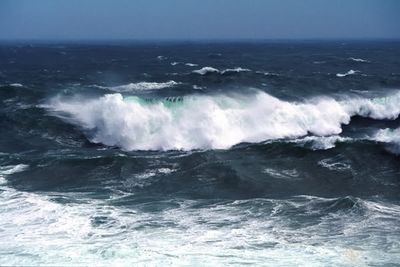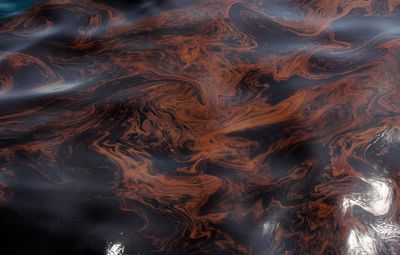May 2010
Go here if you'd like to read this issue on our website.
An email extension of the Pure Water Gazette.
In this late spring Occasional you'll bump into Lord Byron, Madonna, and Steve Maxwell. You'll hear something about the oil leak, of course, and there's news about excessive fluoride at Alaskan military bases, the world's largest beaver dam, and organic matter in the Amazon river. Also, TCE dumping in Nebraska and Rogersville, MO, the lead content of kitchen faucets, and the Sphericity of Anthracite. You'll be shocked to learn about the per-chair water needs of a barber shop and the amount of water required to refine a gallon of crude oil. Find out how to convert pounds of steam per hour to horsepower in boilers, what SDI stands for and, as always, much, much more. The Occasional is loosely overseen and edited by Pure Water Gazette Editor in Chief Hardly Waite.
Water News from Around the World
While you were dancing around the Maypole, a lot of important things happened. Follow the links if you don't want to be left in the dark.
A Minnesota congressman has introduced legislation designed to “fix” the Clean Water Act, which has been damaged by recent Supreme Court rulings.
As public water systems age and maintenance funds are in short supply, corporations are waiting in line to gobble them up.
Water was declared unsafe for several days because of excessive fluoride at two Alaskan military bases.
The world’s largest beaver dam was discovered in northern Canada.
University of Georgia researchers have been awarded $2.4 million to study organic matter flowing from the Amazon River into the Atlantic.
The water supply of more than 2 million Californians has been exposed to harmful levels of nitrates over the past 15 years.
A research team at Tel Aviv University concluded that UV light is superior to chlorine as a disinfectant.
The President’s Cancer Council issued a recommendation for use of home water filtration systems to reduce exposure to carcinogens.
The Environmental Protection Agency has added 6,300 new chemicals and 3,800 chemical facilities to its public database.
The U. S. Geological Survey is now offering WaterAlert, a new service that sends subscribers instant, customizable updates via e-mail or text message about water conditions.
Ammonia in Sacramento’s poorly treated waste water is lowering fish populations in the San Joaquin River and bankrupting downstream farmers.
Solvents tetrachloroethylene and 1,1-trichloroethane dumped by an engineering company in the 1970s are contaminating wells in Nebraska. A fact to ponder, provided by the EPA: “Groundwater moves down gradient about 1.5 feet a day. It takes 10 years to move a mile.”
America’s response to the cataclysmic oil leak is pathetic. Where is the outrage?
The typical household faucet manufactured over the last fifteen years can contain a quarter pound of lead! Older faucets manufactured before 1996 can contain double that amount.”
Israel leads the world in waste water and sewage recycling at an incredible 70%. Spain comes in a distant second at 12%.
Many wells in Rogersville, MO are being contaminated with TCE. The source remains a mystery.
And, finally, a sad but informative picture history of the spill.
 |
Roll on, thou deep and dark blue ocean-roll! --George Gordon, Lord Byron, Childe Harold's Pilgrimage (1812). Almost two hundred years ago, when the great English poet Lord Byron wrote this moving expression of awe at the power and majesty of the sea, Byron could not have foreseen that man's cunning could in fact someday extend his ruinous reach far beyond the shore. Nor could Byron have imagined greed so blind that it would drive us to punch holes in the ocean's floor a mile below the surface in our lust for more and more wealth. |
|
The Ceiling is Up and the Floor is Down
by Gene Franks
A Rare Pure Water Occasional Book Review
As a foreign language student in college, long, long ago, I was impressed by the really important information you could get from foreign language textbooks. There were practice sentences that provided useful information like "The Rodriguez family is Mexican. They live in a Mexican house." My all-time favorite was, "The ceiling is up and the floor is down." That's a bit of wisdom I have taken through life and have been able to apply to every building I ever entered.
Now that I mainly study water filtration equipment, there are two books, both written in English, that help me a lot. I use each of them almost every day. They are the Entingh Corporation's Engineering Handbook and Alamo Water's Water Improvement Engineering Guide.
The last mentioned was published by Alamo Water Refiners of San Antonio (the copyright date of my copy is 1991, but I have a feeling it goes back further). Alamo Water is now part of Watts Water Quality and Conditioning Products, but the Alamo Engineering Guide lives on. It is a 47-page fine print treasury of very useful information.
Here are some universal truths from the Alamo guide, so helpful they're worthy of inclusion in foreign language textbooks:
If you want to avoid water hammer (and who doesn't?), the size of your pressure tank should be limited to the maximum GPM (gallons per minute) divided by 60 seconds times 2 seconds times 10.
If you want to install electrical equipment in a manhole, quarry or mine, submerged in water, you must conform to Nema 6 Electrical Enclosure Standards.
To use Birm to remove iron from water, the water's Dissolved Oxygen (DO) content must be equal to at least 15% of the iron (or iron and manganese) content.
The Sphericity of Anthracite is 0.61 in loose pack format and 0.60 in tight pack.
When sizing a treatment system for a motel with 50 units, you should allow for 145 gallon per minute flow during peak demand if your toilets have flush valves. With flush tank toilets, 75 gallons per minute is enough.
For bowling alleys, you should plan for 175 gallons daily usage per lane.
If sizing a water system for an oil refinery, allow 80,000 gallons of water per day per 100 barrels of crude processed.
For taverns, plan on 20 gallons per day per seat.
A 2" pipe will support a normal water flow of 65 gallons per minute but you can push up to 120 gallons per minute through it if you have to.
Barber shops need 55 gallons of water per day per chair.
Water boils at 212 degrees F. at 0 PSI pressure, but at 52 PSI it boils at 300 degrees F.
In dealing with boilers, you can convert pounds of steam per hour to horsepower by dividing it by 34.5.
Moderately hard water is defined as water with 3.5 to 7.0 grains per gallon hardness.
A 10" X 54" mineral tank (a common size) holds 1.5 cubic feet of filter medium or softener resin. It has a square foot media surface of 0.54 square feet, holds 0.45 cubic feet per inch of height, is 50" tall to the sideshell, has a media bed depth of 34" and a freeboard (empty space on top) of 16". It supports a softener flow rate of 5.0 gallons per minute and a filter flow rate of 2.7. As a softener tank, it has as 45,000 grain capacity if salted at 22 lbs. per regeneration and 30,000 grains if salted at 9.
A 30" X 72" mineral tank requires a gravel underbed of 200 lbs. of 1/4" X 1/8" gravel to support carbon filter media.
A circular brine tank, 20" in diameter, holds 1.33 gallons of brine per inch of height.
The maximum operating temperature for Filter Ag is 140 degrees F.
Filox is effective between pH 5.0 and 9.0.
Weak acid cation resin is best at reducing alkalinity.
Vaseline or common grease should not be used on softener control valves.
The diameter of a human hair is about 75 microns.
The smallest bacteria measure about 0.2 microns.
It is advisable to feed a dealkalizer with softened water.
A cylindrical tank 3' 2" in diameter holds 58.92 gallons of water per foot of depth.
Manways on top of steel tanks can be either elliptical, flanged, davited, or hinged.
One of the popular manway styles is called a thief hatch.
Ductile iron has the strength properties of steel using casting techniques similar those of gray iron.
EPDM is made from ethylene-propylene diene monomer. It has exceptionally good weather aging and ozone resistance and is fairly good with ketones and alcohols.
A check valve installed near a pump in the discharge line will keep the line full and help prevent excessive water hammer during pump startup.
PVC has an excellent chemical resistance when used with fatty acids, but poly tubing is not recommended.
One gallon of muratic acid is equal in treatment capacity to 3.2 lbs. of hydrochloric acid.
One pound of polyphosphate typically treats 40,000 gallons of water at a 2 ppm concentration, but it is a good idea to slug the system initially at 10 ppm for 30 days to clean out the lines at a faster rate.
It takes 2 to 3 ppm chlorine with 30 minutes residence time to oxidize one ppm H2S.
One oz of calcium hypochlorite equals two level tablespoons.
To calculate the percentage rejection rate of a reverse osmosis unit subtract the product TDS from from the feedwater TDS, multiply by 100, then divide by the feedwater TDS.
SDI stands for Silt Density Index and it is a measurement of suspended solids in RO feedwater.
Watts divided by amps equals volts.
A gallon of water weighs 8.337 pounds.
To figure the gallon capacity of a reservoir, multiply the length by the width by the depth in feet. This gives the cubic foot total. To convert to gallons, multiply the cubic feet by 7.4805.
I could go on and on and on and on. The Alamo Water Improvement Engineering Guide has a million of them.
.
Water Should Cost More: An Unpopular View
Editor's Note: The Pure Water Gazette has long supported the maintenance of excellent, well-funded public water supplies and opposed the privatization of water. We must protect our water from ownership by for-profit agencies, and we're going to have to get beyond the silly notion that water is free. It isn't, and we must greatly increase the price we pay for water so that superb public water systems can be maintained.
The piece below is excerpted from an informative article about the state of the current water treatment industry, A Flood of Challenges - A Sea of Opportunities by Steve Maxwell. --Hardly Waite, Editor, The Pure Water Gazette.
There is no substance more critical to life than water - we cannot live without it for more than a few days.
Modern water treatment techniques and extensive distribution infrastructure have allowed the development of our advanced industrial economies, and have enabled dramatically increasing standards of living for many of the world's people. Modern irrigation techniques have made it possible to feed a rapidly growing world population, and to turn deserts into productive farmland and sprawling metropolises. Yet we continue to deplete and pollute our limited water resources at an alarming rate - and we steadfastly look the other way while
our water treatment and distribution infrastructure begins to crumble.
We are rapidly reaching the point at which we will no longer have sufficient clean water to support our current lifestyles. Half of the world's population is expected to suffer from severe water shortages by the year 2050. Yet, much of our population still seems to simplistically believe that water falls out of the sky and that it should be basically free, forgetting that it costs money - billions and billions of dollars a year - to collect, clean, store and distribute water.
Many of our treatment plants, reservoirs, and distribution pipelines were built fifty to a hundred years ago and are rapidly decaying, with leakage rates as high as 50% in some older cities. More ominously, many of our underground underground aquifers and surface water sources are irreversibly contaminated, or are drying up from decades of overuse.
Nonetheless, political leaders are typically rewarded for minimizing public spending rather than insuring that their communities will have access to vital water resources in the future.
City councils are loath to raise water rates, even though big percentage increases would only amount to a few dollars a month for most Americans.
At a fundamental level, the main reason for this nonchalance and lack of attention is that water remains truly - actually absurdly - cheap relative to its real value. Americans today pay an average of a quarter of a penny per gallon for the clean drinking water that seems to magically flow out of our taps - about $25 a month for the typical family. One simply cannot find another product whose real value so far exceeds its price - or for that matter, one whose price is often so unrelated to its true cost of delivery.
Eventually, we will all bear the costs of correcting the water pollution problems that we have created, and rebuilding the infrastructure that we have allowed to fall into decay - huge costs that current water prices do not properly reflect.
Hollywood starlets pitch all manner of natural spring waters, vitamin waters, energy waters, smart waters, holy waters and various other so-called specialty beverages right up to "Bling H2O" - which proudly calls itself the most expensive bottled water - all now available at a cost of only a hundred to a thousand times the price of the tap water from which they are virtually indistinguishable. Also this year came breaking news that Madonna spends $10,000 a month on specially blessed water, with cartons of it shipped to wherever she is staying at the moment.
There seems to be no end to the appetite of the American public to pay ridiculously high prices for essentially the same thing that comes out of their taps, while simultaneously a $10 or $15 increase per month in tap water fees can generate a political firestorm.
But the fad may be moderating - some upscale restaurants are now promoting the virtues of tap water, and no less a water authority than the National Association of Evangelicals has said, "Spending $15 billion a year on bottled water is a testimony to our conspicuous consumption, our culture of indulgence…. drinking bottled water may not be a sin, but it sure is a choice."
Featured Water Issue : Iron
This issue's featured water treatment item, iron, is not usually a problem for city water users, but for many well owners it's a nightmare. Iron starts being a problem at only 0.3 parts per million, and it isn't always easy to get rid of.
Iron can occur as clear water iron (called ferrous), red water iron (called ferric) and heme iron, also called organic iron. In addition, there are bacteria that love to feed on iron and they create an unpleasant gelatinous slime that can clog up pipes and ruin water treatment equipment.
The main objections to iron are aesthetic: Stained clothing and stained plumbing fixtures.
Iron is often accompanied by manganese, which is similar to iron but causes problems at even smaller concentrations. Hydrogen sulfide gas, rotten egg odor, is also often found where iron is found.
Iron can be removed by a water softener under the right conditions, but it is usually removed by special filters. Pre-oxidation with air, chlorine, hydrogen peroxide or another oxidizer is often required before filtration.
For more information about iron, please visit the Occasional's ever-growing Water Treatment Issues section.

Numerical water facts from B. Bee Sharper, the Pure Water Gazette's numerical wizard.
This month, Bea B. has been busy recording the never-ending string of numbers spewing from the bottom of the Gulf of Mexico, so you'll have to be content with a One-Item Essay. Keep this in mind when you're ready to start whining when the price of the water that flows clean and clear from your faucet goes up to a penny a gallon:
Number of the Earth's people who must walk at least three hours to obtain drinking water: 1,000,000,000.
Go here for More B.B. Sharper.
Please visit the Pure Water Occasional's Website.


